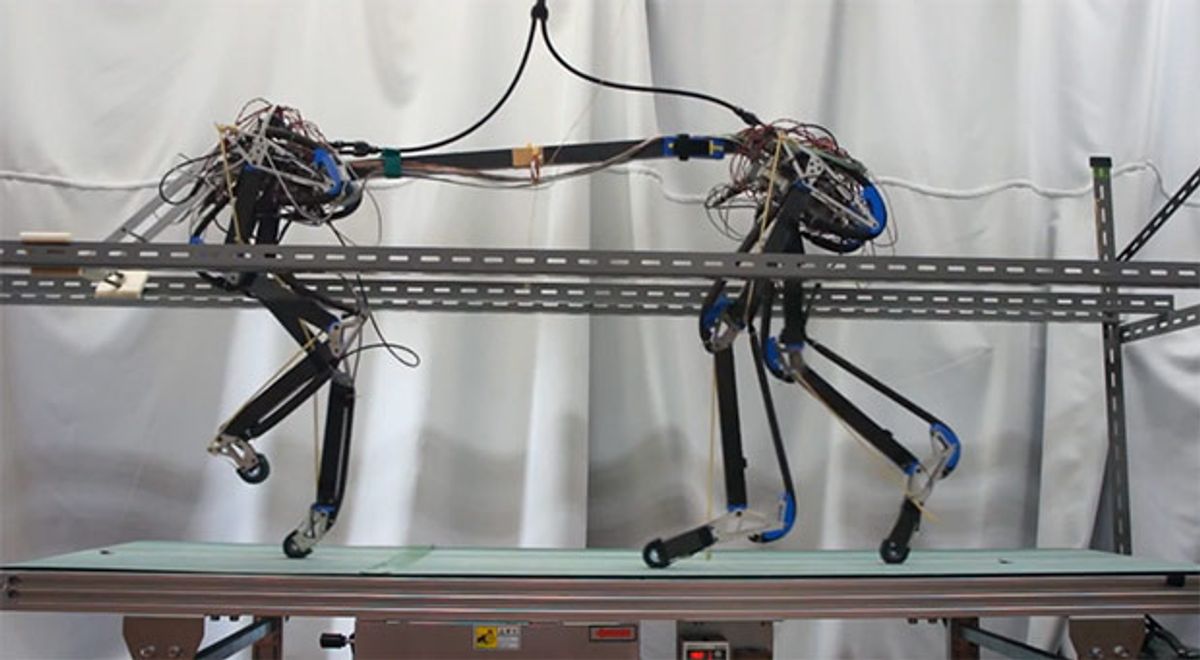Last year, Boston Dynamics' Wildcat quadruped robot managed to "escape" its lab in spectacular style, galloping in a parking lot at up to 25 km/h (16 mph). But Wildcat is just one of a growing pack of quadrupeds under development in robot laboratories around the world.
Another example, hailing from Osaka University, is Pneupard, a biologically-inspired quadruped robot powered by pneumatic muscles. When we last saw this robot over a year ago, it was far from complete. Now a new version, equipped with all four limbs, is taking its first steps.
To make the robot walk, the Osaka University researchers had to individually fine-tune the air pressure of each muscle as the robot moves its legs. You would think that the more muscles you add to the legs, the more capable the robot becomes. That is true, but the trade-off is that the more muscles you have to manage, the more complex and time-consuming the job becomes.
The original version of Pneupard that the team designed had a lot of pneumatic muscles and controlling the robot became a huge challenge. So the researchers decided to adopt a "lean and mean" approach to its anatomy and built a second version with fewer muscles. This made it easier to control the machine and explore different gaits.
The work takes place at the laboratory of Prof. Koh Hosoda and the team includes Andre Rosendo, Shogo Nakatsu, Xiangxiao Liu, and Masahiro Shimizu.
The researchers say the new approach allowed them to shift focus from individual limbs to their collective behavior. In other words, now they can study how the legs work together to create stable motions and efficient gaits. In one of their first experiments, the 4.8-kilogram (10.5-pound) robot can be seen walking on a treadmill, daintily lifting its mechanical paws with each step, helped by a supporting shaft that prevents it from falling over sideways.
"Our belief is that locomotion is created not only by the brain, but also the brainstem, spine, and muscles, which also 'have a say' on how the body moves," Rosendo, the project leader, tells IEEE Spectrum in an email.
As an example of how the brain is not the only entity responsible for body movements, Rosendo mentions the famous case of Mike the Headless Chicken, a chicken that allegedly lived for 18 months after its head had been cut off. He adds that bioinspired robots let researchers explore how locomotion works without having to use live animals. While far from perfect models of their biological counterparts, these robots may reveal important clues by exhibiting similar principles.
For example, in the video above, note that the robot does not require a complex brain, nor does it use any ground feedback or sensors (it's an "open loop" experiment, in control systems parlance). It walks through the physical interaction of its skeletal structure and muscles, which are controlled by a simple, rhythmic controller called a central pattern generator, or CPG.
The team has already installed some force sensors on the robot's "paws" (not used in the video), which should help further their work with CPGs, as well as gait transitions and the contribution of the limb stretch-reflex.
Now that Google has bought out Boston Dynamics, it's hard to say what the future holds for its quadruped robots, and we wonder if we'll ever see them again. At least we can still look forward to more cat-like action from the team at Osaka University and also from groups at MIT and EPFL, both of which are working on feline robots of their own.
[ Hosoda Lab, Osaka University ]




